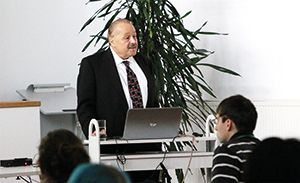European Short Course on Time-Resolved Fluorescence Spectroscopy Offered
PicoQuant, a research and development company specializing in optoelectronics and based in Berlin, Germany, is collaborating with Joseph R. Lakowicz from the Center of Fluorescence Spectroscopy (CFS) in Baltimore, Maryland, to offer a short course on the “Principles and Applications of Time-Resolved Fluorescence.”
PicoQuant, a research and development company specializing in optoelectronics and based in Berlin, Germany, is collaborating with Joseph R. Lakowicz from the Center of Fluorescence Spectroscopy (CFS) in Baltimore, Maryland, to offer a short course on the “Principles and Applications of Time-Resolved Fluorescence.”
The four-day event, taking place November 5–8, 2018 at the WISTA Campus in Berlin, features an in-depth introduction to fluorescence spectroscopy and its applications to scientific fields such as life and materials science. Researchers from academia and industry interested in using fluorescence spectroscopy methods are encouraged to attend the course, which encompasses a series of lectures with accompanying practical sessions focusing on various instrumentation and software.
Instructors include Joseph R. Lakowicz from CFS; Zygmunt “Karol” Grycznski from the Texas Christian University in Fort Worth, Texas; Ranier Erdmann, PicoQuant’s managing director; and other senior PicoQuant scientists with extensive experience in time-resolved fluorescence spectroscopy. The practical sessions will focus on steady-state and time-resolved measurements, as well as data analysis. Instruments will be provided by Agilent and PicoQuant.
Joseph R. Lakowicz giving a lecture during the time-resolved fluorescence course.

This year’s course will cover a range of topics, including the basics of fluorescence spectroscopy; instrumentation and data analysis, time-domain and frequency-domain measurements; anisotropy; solvent effects, quenching, Förster Resonance Energy Transfer (FRET); fluorescence sensing; fluorescence spectroscopy in biophysics and material science; and plasmon-controlled fluorescence.
For more information, please visit http://www.picoquant.com/trfcourse or contact Nicola Kasse at trfcourse@picoquant.com
Spectroscopy and GPC to Evaluate Dissolved Organic Matter
February 4th 2025In a new study, a team of scientists used gel permeation chromatography, three-dimensional excitation-emission matrix fluorescence spectroscopy, and UV-visible spectroscopy to assess road runoff from drinking water treatment plants to evaluate the method' capacity for removing dissolved organic matter (DOM).
Blood-Glucose Testing: AI and FT-IR Claim Improved Accuracy to 98.8%
February 3rd 2025A research team is claiming significantly enhanced accuracy of non-invasive blood-glucose testing by upgrading Fourier transform infrared spectroscopy (FT-IR) with multiple-reflections, quantum cascade lasers, two-dimensional correlation spectroscopy, and machine learning. The study, published in Spectrochimica Acta Part A, reports achieving a record-breaking 98.8% accuracy, surpassing previous benchmarks for non-invasive glucose detection.
Distinguishing Horsetails Using NIR and Predictive Modeling
February 3rd 2025Spectroscopy sat down with Knut Baumann of the University of Technology Braunschweig to discuss his latest research examining the classification of two closely related horsetail species, Equisetum arvense (field horsetail) and Equisetum palustre (marsh horsetail), using near-infrared spectroscopy (NIR).